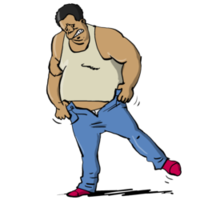Tomatoes and Prostate Cancer: What to Do? What to Do?

In June a new study on tomato intake and prostate cancer was published in the journal Cancer Epidemiology Biomarkers and Prevention and it really put the cat among the pigeons.
I am sure that you have heard a bit about the studies that seemed to show a protective effect of tomatoes on prostate cancer, and those studies have lead to large advertising campaigns by the manufacturers of the phytochemical lycopene, which is though to be a key component of the protective effect. Lycopene has attracted particular attention because it happens to be concentrated in some of the cells of the prostate gland.
Then along comes this study suggesting that lycopene offered no protection against prostate cancer in a group of 28,000 men.
It is just the latest in a long line of research into the effects of lycopene-containing foods, and as I said, the majority of previous studies have suggested that tomatoes and tomato-based products offer some measure of protection against prostate cancer.
One of the key points that is so often not discussed, is that loading up on any one food or food supplement is not a good idea and certainly not supported by the research. For foods to be effective in humans, they may well have to be in their natural form, and the strongest evidence shows that diets high in a variety of different fruits, vegetables, whole grains and beans are associated with lower risk of developing heart disease, cancer and several other problems.
It is certainly true that in the laboratory, tomato components have stopped the proliferation of several types of cancer cells including breast, lung, and endometrium. In animal models, consumption of large amounts of compounds extracted form tomatoes has been linked to large decreases in prostate cancer risk.
The best known study recruited 47,894 men and evaluated their diets for six years. The data showed that those who ate the most tomato products – raw, cooked tomatoes, tomato sauce, pizza and tomato juice – had a 35% lower risk of early prostate cancer and a 53% lower risk of advanced prostate cancer than men who ate the least of these foods.
We are all eagerly awaiting the publication by the American Institute of Cancer Research and its international affiliate organizations on November 1st of this year, of the most comprehensive assessment of the scientific literature on diet, physical activity and cancer risk ever undertaken.
That report, Food, Nutrition, Physical Activity and the Prevention of Cancer: A Global Perspective, will synthesize data from thousands of studies and provide guidelines for the public and for the scientific/medical community. It is bound to be controversial, but hopefully it will provide answers to questions about nutrition and cancer that are based on a thorough review of the available science.
(You can find out more about the WCRF/AICR Expert Report here. I am looking forward to reading the report and I shall be taking you through the highlights as soon as I get a copy)
Let me re-iterate one of the principles of Integrated Medicine, that is so very important when considering the impact of nutrition on health:
Combinations are Key for they create a powerful synergy.
Whole Grains

Every day of the week I talk to people who say that they do not have time to eat a healthy diet or hunt for the right type of victuals, and so off they go to the health food store to buy some capsules.
How many advertisements have you seen for some capsule or powder that gives you all the nutrients and fiber that you need? But think about that for a moment: does that make sense? For millions of years our far-distant ancestors co-evolved with the plants and minerals around them. So does it make sense that we can pull out one dietary component and ignore the rest? Or that the berries of some plant growing thousands of miles from early humankind could contain some magic potion that will solve all of our problems? That would imply a rather capricious Universe that only wants you to find that essential something when you have the money and the wherewithal to find.
Back when the world was new – well, come to think, it was 1974 – I was impressed to see some early data that showed dramatic differences between the exquisitely balanced nutrient profile of an orange compared with commercially prepared orange juice. A few years later we even did a bit of research on the subject.
This topic has re-emerged with some new research that has received justified plaudits from experts at the American Institute for Cancer Research. The study has indicated that whole grain fiber rather than fiber from other food sources, is associated with lower risk of colorectal cancer.
The study was recently published in the American Journal of Clinical Nutrition and found that consumption of whole grains was associated with lower risk for colorectal cancer. The same study found no significant link between consumption of fiber from other food sources and colorectal cancer risk.
Researchers at the National Institutes of Health analyzed survey results from a huge prospective cohort study called the NIH-AARP Study involving more than 291,000 men and 197,000 women aged 50 to 71.
The scientists analyzed the participant’s intake of fiber from many different food sources, but only fiber from whole grains was associated with lower risk of colorectal cancer. In the study, those subjects who ate the most whole grains had a 20 percent lower risk of colorectal cancer than those who ate the least.
The observed protective effect of whole grain consumption was stronger for rectal cancer, with a 35 percent lower risk.
Experts have been following the conflicting and often contradictory findings on fiber and colorectal cancer for years.
Much of the previous research simply measured the participants’ total fiber intake. The trouble is that so much of the American diet is now made up of heavily processed grains in foods like pasta, cereals and breads, so “Fiber” is a really mixed bag. So it seemed that it might be helpful to distinguish between different food sources of fiber.
Let’s have a quick refresher course. All grains, from the familiar, like wheat, oats, rye, corn, to the less well known such as barley, bulgur, millet, quinoa start out as kernels. The bran is the outermost layer of the kernel, and that is where most of the fiber is found. The germ lies at the center of the kernel, and that is where most of the vitamins, minerals and fatty acids reside. In between the brain and the germ lies the endosperm, which contains a few vitamins and minerals and most of the starch.
Because the refining process removes the bran and germ, the main component of white bread and other products made from refined grains or white flour is starch. Whole grain products are darker and chewier than refined grain products is because all three layers of the kernel are ground together to make whole grain flour. This provides the kernel’s full complement of protein, fatty acids and a range of phytochemicals. Most importantly, perhaps, the fiber content of whole grains can be as much as four times that of refined grains.
The evidence connecting consumption of whole grains to reduced risk for cancer, cardiovascular disease, stroke and diabetes comes chiefly from population studies and laboratory work. Only recently have researchers begun to identify specific ways a diet high in whole grains promotes health.
In February 2006 a study also published in the American Journal of Clinical Nutrition found that a high whole-grain intake had a number of objective effects on physiological markers – homocysteine, plasma markers of glycemic control (fasting insulin, hemoglobin A1c, C-peptide, and leptin), lipids (total cholesterol, triglyceride, HDL cholesterol, and LDL cholesterol), and inflammation (C-reactive protein, fibrinogen, and interleukin 6 – that may be associated with both diabetes and cardiovascular disease almost all improved and none became worse.
The evidence for whole grains specifically lowering cancer risk is less strong. However, in 2003 European Prospective Investigation into Cancer (EPIC) prospectively examined the association between dietary fiber intake and incidence of colorectal cancer in 519,978 individuals aged 25 to 70 years, recruited from 10 European countries. The data showed that high consumption of fiber (from fruits, vegetables and whole grains) reduced risk for colon cancer by 25 percent.
Although most experts have been recommending “whole grain foods” for years, this new study finally proves that the fiber that we get from whole grains is different from the fiber we get from “starchy” foods like white bread and processed cereal, and that these differences are not only important for the vascular system and diabetes, but also for cancer risk.
Non-pharmacological and Lifestyle Approaches to Attention-Deficit/Hyperactivity Disorder: 11. Integrated Medicine

The whole point of Integrated Medicine and Integrated Health is to help the person with attention-deficit hyperactivity disorder (ADHD) to become integrated as a person by using an integrated approach to treatment. This kind of comprehensive approach is particularly important for many people with ADHD. I also want to re-emphasize that although ADHD is the approved term for the problem, many people, particularly adults, may have little overt evidence of hyperactivity, and they are better thought of as having “ADD.”
Attentional problems come in all shapes and sizes. Some are so mild that people just need to be shown how to use a day planner and implement some time management scheme. Others need a more aggressive and comprehensive approach. Whatever we do has to be individualized to the person with the problem. Not only do we have to match the plan with the person, we also need to match it with his or her belief system.
It is important to recognize that no one approach is likely to work on its own. Medications may be very helpful, but they are only tools to help people get organized so that they can fulfill their potential. And medications are unlikely to be effective unless we also deal with nutrition, posture, breathing, sleep and environmental stress.
It is also essential to realize that ADHD is highly co-morbid: there is evidence of increased rates of physical problems, including disturbances in thyroid function and cell membrane function throughout the body. The rates of conduct disorder, oppositional defiant disorder, learning disabilities, tics and Tourette’s, worry, anxiety and mood disorders are all much higher in people with ADHD. So high that until recently, many experts believed that ADHD was a symptom rather than a clearly delineated illness. This overlap is also one of the reasons why some people persist in saying that the diagnosis of ADHD is nothing more than a stigmatizing label for socially unacceptable behavior.
Physical
- Medications
- Nutrition
- Posture
- Exercise
- Environment
Over the last few weeks we have spent a lot of time looking at some of the options for treating the physical components of the problem. Now let us look at the rest.
Psychological
- Find out and work with a person’s interests. ADHD is highly dependent on context. A child or adult may have terrible problems with schoolwork, but be able to play a video game for hours on end
- There are multiple intelligences: uncover which are of the greatest importance. It is essential for a person to discover their strengths rather than being forced to focus on the weaknesses. Many people with ADHD find that highlighting text in a book can be useful, while others learn by doing
- People are more likely to follow instructions if they are interesting and emotionally charged
- Bear in mind that many people have poor self-esteem and others suffer from enormous feelings of regret. This is a particular issue for people who may have reached middle age before being diagnosed. We have seen countless people who feel that they have missed out on life. A man working in construction realized that he could have gone to college thirty years ago if only his ADHD had been diagnosed and treated
- Teach visualization skills
- Discover which times of the day are best in terms of attention and alertness
- Learn some simple relaxation techniques
- Learn problem-solving skills
Social
- ADHD can play havoc with relationships. If a child has it, there can be enormous stress on the parents and siblings, all of whom are at higher risk of some features of ADHD themselves. It is essential to help the family with coping skills. ADHD can also put a great deal of stress on a spouse or children. It is also important to know that many people with ADHD have sexual problems that stem from impatience, a low frustration threshold if they cannot have sex when they want it, and real problems with enjoying the moment and taking time to enjoy a romantic interlude. Some people also use sex as a form of self-medication. So it is essential to find out if there are sex or relationship problems and to deal with them, which may need outside help
- Many people with ADHD are socially awkward and may need to learn some social and communication skills
- ADHD and social awkwardness can be magnets for bullies, and it is remarkable how many young people with untreated or inadequately treated ADHD have been bullied. Occasionally they become the perpetrators of bullying to compensate for their difficulties. In either case it is important to discover and deal with bullying. It is one of several reasons why some experts have recommended enrolling a child in martial arts classes. Not only can they help with self-defense, but also the discipline of a martial arts class can work wonders for some people with ADHD
- Role models are important for people with ADHD. It is very helpful, particularly for young people to see that other sufferers have become extremely successful
- It is also important for parents and other family members to develop and maintain a positive image of the person with ADHD
- Develop positive yet realistic career and life goals
Subtle
- Poor breathing techniques can engender many problems. Learning to breath effectively can have profound physical effects as well as stimulating and balancing the subtle systems of the body
- As we have seen, although the research base is very small, yoga, t’ai chi ch’uan or qigong can all be very helpful
- Many people with ADHD are acutely sensitive to “atmosphere:” to the thoughts, feelings and attitudes of other people, and they need specific help to remain grounded and to protect their senses. Some of the flower essences can very helpful for that, as well as some other techniques that we shall be publishing shortly
Spiritual
- How can there be a spiritual component to ADHD? Some people find it difficult to engage in prayer or meditation because of problems with attention. However, with a little perseverance, we have evidence that some forms of meditation may actually help.
- Second the rituals of religion can sometimes provide a wonderful anchor for the person who is having a had time with ADHD.
- Another point is that ADHD is not all bad. Some people who have it become more attuned to nature, animals and to a mystical understanding of the world: an over-reliance on reasoning and linear learning can stifle those perceptions.
- Some people have suggested that ADHD may for the same reasons unlock a rich vein of creativity that might otherwise never have appeared.
There are plenty of books and websites that portray ADHD as a gift. While I have the greatest respect for this approach, it is still important for us not to forget the demonstrable problems caused by inadequately treated ADHD.
ADHD exists, it is treatable, and though it can bring many problems, it can also bring many opportunities. Just so long as we remember to respect every dimension of the person who has it, and remember that if we do not manage it, it will manage us.
Goldilocks and the, err, Vitamins

We are often told that we should take much higher amounts of many vitamins than the doses that are usually recommended.
The late Linus Pauling was one of the most famous proponents of the idea of using huge amounts to Vitamin C to present colds and an array of other health problems. Over the years I have heard enough recommendations to confuse anyone: and one of my degrees is in biochemistry! The only answer with so many conflicting pieces of advice is to do some good research.
Vitamin A is an important fat-soluble vitamin involved in the maintenance of many of many key systems in the body. The recommended daily allowance for vitamin A is 5000 international units (IU) for adults and 8000 IU for pregnant or lactating women.
Vitamin A deficiency is one of the major nutritional problems worldwide and it threatens the survival and health of millions of children. According to a report published in 2002, 127 million preschool children and 7·2 million pregnant women are deficient in vitamin A.
Vitamin A deficiency can cause night blindness, drying and degeneration of the cornea that can lead on to total blindness, as well as impairment of the immune system.
Children living in regions where vitamin A intake is insufficient need to receive adequate amounts of vitamin A through breastfeeding, together with improved diets, food fortification and supplementation with vitamin A.
Providing vitamin A supplementation in countries where there is a deficiency of the vitamin has been proven to decrease mortality. As a result, most developing countries have adopted a standard World Health Organization (WHO) dosing schedule for vitamin supplementation, which calls for 200,000 IU to mothers early postpartum and then 200,000 IU every 4 to 6 months. For infants, the recommendation is 100,000 IU at 9 months and 200,000 IU at 12 months.
However, in 2002 the International Vitamin A Consultative Group (IVACG) Annecy Accord recommended a new high-dose regimen for mothers and infants which includes a doubling of the initial postpartum dose for mothers, and adding 50,000 IU at 2, 3 and 4 months for infants.
An article just published in the Lancet indicates that this high dose protocol does not have any benefit over the older recommendation.
Professor Andrew Prentice and a team of researchers at the International Nutrition Group at the London School of Hygiene and Tropical Medicine in London and colleagues, studied 220 women-infant pairs in an area of moderate vitamin A deficiency in Gambia. One group received the WHO recommended dose, while the other received the IVACG recommended dose.
They measured blood plasma levels of vitamin A, the incidence of Helicobacter pylori infection, how many of them had pneumococcus in the nasopharynx and the integrity of the infants’ intestines.
The problem is that too much vitamin A can also create problems, including nausea and vomiting, jaundice, irritability, anorexia, blurred vision and worst of all, increased intracranial pressure that can cause headaches, drowsiness and even death. These are not such big problems in well-nourished adults living in the Western world, but in malnourished infants, particularly if they are also being vaccinated, this can be a big problem.
There is one specific occasion when a high dose of Vitamin A can be helpful: if a child in a deficient area gets severe measles, the WHO recommendation is that two doses of 200,000 IU should be given to the child. It is easy to forget that in some parts of the world measles can be a killer.
The authors of the article, as well as an accompanying editorial suggest that we should be looking at lower, rather than higher doses of vitamin A.
The editorial is by Professor Bernard Brabin of the Child and Reproductive Health Group in Liverpool, England and he finishes by saying,
“Future trials should emphasize the importance of exclusive breastfeeding, because early feeding with formula milk might reduce potential benefits from early supplementation with vitamin A in infants.”
This story shows us once again the extreme importance of having just the right amount of a vitamin or nutrient.
If someone claiming to be an expert in nutrition or vitamin therapy tells you to “take as much as you want” of anything, please be careful.
Just remember the story of Goldilocks and the Three Bears….
Red Meat and Breast Cancer
There is an important study that was published in the April issue of the British Journal of Cancer, but which I haven’t seen reported in the United States.
The researchers did a survival analysis to assess the effect of meat consumption and meat type on the risk of breast cancer in the UK Women’s Cohort Study. Between 1995 and 1998 a cohort of 35,372 women was recruited, aged between 35 and 69 years with a wide range of dietary intakes, assessed by a 217-item food frequency questionnaire. The researchers also took into account smoking, weight, fruit and vegetable intake, class, education and use of hormone replacement therapy.
The results showed that eating even small amounts of red meat daily can increase the risk of breast cancer by 56 per cent in older women.
As little as 2oz (57g) of beef, lamb or pork a day showed an effect. Post-menopausal woman who ate larger amounts, 3.6oz (103g), of processed meats such as sausage, bacon or ham had an increased risk of 64 per cent.
Even younger, pre-menopausal women had a slightly raised risk if they ate red meat daily.
Earlier analysis from the study found that pre-menopausal women who had the greatest intake of fibre cut their breast cancer risk by half.
The Leeds work supports other studies. In November, a study from the United States found that women who ate the largest amounts of red meat had a rising risk of breast cancer. But different studies have presented conflicting views.
One reason why red meat may contribute to a raised risk of breast cancer is that it is a rich source of saturated fat. The women who ate the most meat were also more likely to be fatter.
The publication of the study in the United Kingdom generated a great many negative comments from the meat industry.
One spokesperson, on hearing that as little as two ounces may be enough to increse the cancer risk said,
"Two ounces is absolutely tiny. I have never heard such rubbish. It’s a tiny amount. This is ridiculous, it’s silly."
I doubt very much that it is "silly," though it is a surprise that the study has not attracted more attention.
The best way to look at this data is not to say that everyone should become vegetarian, but to recommend that women should:
- Eat a balanced diet
- Limit alcohol consumption
- Exercise regularly
- Keep and maintain a healthy weight
- Try to maintain a regular sleep schedule
Neurological Complications of Gastric Bypass Surgery

Our bodies are highly complex systems. They are not just bags of randomly assorted organs. So tinkering with one part of the system can have an impact in an entirely different part of the body. Many of us have worried for some time about the long-term consequences of gastric bypass surgery for weight loss. We know that some people who have had the surgery develop “substitution addictions.” If they had a real addiction to food before the surgery, after it they may begin to develop an addiction to something else, such as drugs or alcohol.
Now neurologists at the University of Arkansas for Medical Sciences (UAMS) in Little Rock have reported the results of a ten-year study found a link between gastric bypass surgery and several serious neurological conditions.
The study was published online May 22 in the medical journal Neurology and concludes that patients who undergo gastric bypass surgery, also known as bariatric surgery, are at risk for long-term vitamin and mineral deficiencies and as a result may develop a variety of neurological symptoms.
We know that ever more of these operations are being done every year, and so long as people are motivated they are usually successful in reducing weight. But they are not without risk, and we always have to balance that risk against the risk of being morbidly obese. This work is important because it suggests that there is an extra risk about which we previously knew very little. Many of the complications that patients experience affect the nervous system, and they are often disabling and irreversible.
More than 150 patients who came to the UAMS Neurology Clinic following gastric bypass were included in the report. In 26 of these patients a link between the surgery and their neurological condition was found.
All of the patients involved in the study had previously undergone what is known as the Roux-en-Y gastric bypass procedure in which a small stomach pouch is created by stapling part of the stomach together and bypassing part of the small bowel, resulting in reduced food intake and a decreased ability to absorb the nutrients in food. The interval between surgery and onset of neurological symptoms ranged from 4 weeks to 18 years.
The neurological problems involved many different parts of the nervous system, and the symptoms included confusion, auditory hallucinations, optic neuropathy, weakness and loss of sensation in the legs, and pain in the feet, among other conditions. None of the patients had prior neurological symptoms.
Many of the patients also experienced multiple nutritional abnormalities, especially low serum copper, vitamin B12, vitamin D, iron and calcium.
This study underlines something very important. Many heavy people are actually malnourished, because they eat the wrong things and an excess of fat in the diet can create problems in the absorption of some vitamins and minerals. In addition, surgery like this can cause a form of malabsorption.
It is therefore essential to make sure that people who have this kind of surgery have an adequate long-term intake of vitamin and mineral supplements to prevent these neurological complications. It is important for everyone to know about these potential problems and to be on the lookout for neurological symptoms.
Diets Make You Fat

Most people who have tried dieting know a sad truth: they do not usually work for very long. Our bodies are designed to form and retain fat stores and millions of years of evolution have created sophisticated and elegant systems to thwart any attempt at self-starvation. That is the real reason why most quick fix promises are doomed to failure. As day follows night, every time that a scientist somewhere publishes another piece of the obesity puzzle, a flurry of articles and books will follow, claiming that they have The Answer, never realizing that there are several hundred interlocking pieces to the puzzle.
Yet more research has confirmed that diets rarely help. A group of investigators from UCLA published their findings in the April issue of American Psychologist, the journal of the American Psychological Association.
Traci Mann and her co-authors have conducted the most comprehensive and rigorous analysis of diet studies that I have ever seen. They analyzed 31 long-term studies in which people were followed for two to five years. What they found clearly mirrors clinical experience. Most people can initially lose 5 to 10 percent of their weight on any number of diets: low carb; low fat; high protein or pretty much anything else. But then the weight comes back: in the majority of people they regained all the weight plus more. Sustained weight loss was found only in a small minority of participants, while complete weight regain was found in the majority.
Their conclusion: diets do not lead to sustained weight loss or health benefits for the majority of people. And since people who regain weight usually have the “bounce” where they regain with interest, most people would have been better off not going on the diet at all. This is important: aggressive dieting can be dangerous to the body. It has been suggested that repeatedly losing and gaining weight is linked to cardiovascular disease, stroke, diabetes and altered immune function. So if people had not dieted, their weight would be pretty much the same and their bodies would not have suffered the wear and tear from losing weight and gaining it all back.
Over the years, many diet studies have looked good, but the results have often been skewed by a number of factors. For example, in some studies participants self-reported their weight by phone or mail rather than having an objective weight measurement. Many studies also had very low follow-up rates: eight of the studies had follow-up rates lower than 50 percent.
Traci Mann, the lead investigator was asked, “If dieting doesn’t work, what does?”
“Eating in moderation is a good idea for everybody, and so is regular exercise,” Mann said. “That is not what we looked at in this study. Exercise may well be the key factor leading to sustained weight loss. Studies consistently find that people who reported the most exercise also had the most weight loss.”
Happily there ARE genuine solutions to the problems of weight, but they do not begin with a diet. They begin with a totally new understanding of how our bodies operate, how to deal with the psychological and social barriers to health and how to activate the natural abilities of the body balance and heal itself.
I am going to talk about those a little more in the next post.
“I’ve been on a diet for two weeks and all I’ve lost is fourteen days.”
–Totie Fields (American Comedian, 1930-1978)
“The Diet Mentality has come about because there is agreement in our society that the only way to lose weight is by dieting. But dieting produces absolutely no permanent, positive results. In fact, it makes you feel worse about yourself and probably does more damage than good to your health.”
–Bob Schwartz (American Health Expert and Author)
“Gluttony is the source of all our infirmities and the fountain of all our diseases. As a lamp is choked by a superabundance of oil, and a fire extinguished by excess of fuel, so is the natural health of the body destroyed by intemperate diet.”
–Robert Burton (English Cleric and Writer, 1577-1640)
Genes, Geography and Culture

The science bug bit me early in life. As a young schoolboy I was fascinated to read the exploits of explorers and collectors. Charles Darwin’s amazing adventures were stirring stuff to a teenager.
The other day I was thinking about all those books that I read after I spotted an interesting article in the Daily Telegraph by Professor Steve Jones, who is a geneticist at University College London, and someone who always makes you think.
Bob Geldof – he of the Boomtown Rats and Live Aid fame – has set up an ambitious project to map cultural differences around the globe before the peoples of the world sacrifice their cultural individuality on the altar of Western consumerism, blue jeans and cell phones.
Anyone who travels as much as I do cannot help but be dismayed at the cultural homogenization that’s happened over the last 25 years. A bit jet lagged, I once woke up in a hotel in the wee small hours and called the front desk to ask which country I was in. I had been in seven in the last two days and there were no clues as to my location when the chauffeur dropped me off just before midnight. It turned out to be Switzerland and the man at the desk told me that it was a common question.
Although I lament the loss of cultural identity, it is not all bad. But it raises some very interesting questions.
While Bob is recording vanishing cultures, geneticists are trying to establish which behavior is determined by DNA and which by our environment.
Steve Jones was meditating on the question of whether local changes in customs inborn or learnt. My schoolboy hero Darwin was also interested in that question and set out to discover whether expressions of fear or joy varied from place to place. The idea was that they might if they were passed on culturally rather than genetically. He corresponded widely on the subject and Steve reminded me of something that I had not read in 30 years:
“Mr. B F Hartshorne… states in the most positive manner that the Weddas of Ceylon never laugh. Every conceivable incitive to laughter was used in vain. When asked whether they ever laughed, they replied: ‘No, what is there to laugh at?”
Darwin finally concluded that expressions of happiness or anger were universal. They had, he thought, evolved, because he fancied that he could detect hints of human laughter in the grin of a tickled chimpanzee.
Some behaviors have a genetic basis. The absence of cheese and milk from Chinese cuisine is normally attributed to the few cows in the country, or the influence of traditional Taoist notions of what items may appear in the same space. But it may have just as much to do with the high rates of lactose intolerance amongst Chinese populations. The Scots have a high frequency of a gene that makes it easier for them to digest cows’ milk, so milk – sometimes cleverly disguised – seems to appear on almost every Scottish menu.
There is an interesting sidebar here. A recent study that analyzed DNA in Neolithic human remains seems to have uncovered the first direct evidence that modern humans have evolved changes in response to natural selection.
According to a new analysis of fossilized bone samples, as recently as 7000 years ago, Europeans were unable to digest milk. Today more than 90% of the Northern European population can. It is most likely that Europeans incurred a rapid change in their genetic make-up because it held an evolutionary advantage for them to be able to digest milk.
Lactose is a sugar in milk, and around the world the majority of humans lose the ability to digest it before reaching adulthood. This is because their gene for the enzyme lactase, that is responsible for breaking down lactose, is switched off by late adolescence. However, over 90% of northern Europeans have a version of the lactase gene that remains active throughout life, enabling them to continue drinking milk as adults. This genetic change appears to have happened around 7,000 years ago and spread rapidly. In the climatic conditions of the time, milk drinking could have conferred a huge survival advantage: unlike water, milk in usually uncontaminated by parasites, and is available year round, unlike seasonal crops. Milk also contains vitamin D and calcium, and in the dim sunlight of Northern Europe, where people may not be able to make enough vitamin D in their bodies, making calcium absorption difficult. Milk would have solved both problems.
So what we might be seeing here is an environmental factor changing gene expression, which in turn has a social and cultural outcome.
Steve Jones’ article talks about some other cultural differences that may have genetic roots. One very recent study purports to show that the number of sexual partners of American male (but not female) college students is related to variation in a gene called dopamine transporter gene (DAT1). The gene codes for a dopamine transporter protein that limits the level and duration of dopamine receptor activation. It is a strong candidate gene for reward-seeking behavior. Dopamine is known to be involved in the reward or “salience” systems of the brain and is known to influence sexual behavior in mice.
The DAT1 gene comes in two distinct forms. Young men with a single or double copy of one of the variants have, it is claimed, twice as many sexual partners on average as do those with a double hit of the different and less common form of the gene. The latter group, about one young man in 10, are far less romantically daring than average. They are also less likely to be involved in drug abuse or to get in trouble with the law. Research like this is complex. To quote Gregory House, “People lie.” And when it comes to doing research on sexual behavior they lie a lot. And it is a fool’s game to try and reduce human behavior to a single gene. I am sure that if you think about it for a moment, you can come up with at least a dozen reasons why people are likely to have more sexual partners.
Levels of promiscuity vary greatly from place to place. There has been a myth circulating that the AIDS pandemic in Africa is caused by promiscuity. In fact there is less promiscuity in Africa than in the West. It is no surprise that young people less sexually active in Bangladesh than in Britain. For years now, anthropologists have speculated about what lies behind these variations, from the wild and socially sanctioned polygamy of a few males in certain ancient – and some not so ancient societies to the modern Western practice of serial (and approximate) monogamy. Recently researchers have begun to ask whether the differences might be due to genetics rather than the ownership of land or cattle, or social or religious mores.
The American DAT1 study shows that although DNA might have a strong effect on the behavior of individual men, it is unlikely to be responsible for cultural differences in sexual behavior. The students in the study were classified as of European, Black, and Asian or Hispanic origin. There are problems about racial classification: few are clear-cut. We are most of us far more mixed than some people would like to believe. The overall frequencies of the two variants were roughly the same within each ethnic group; and within each seemed to have the same effect. The Asian Americans, though, had fewer than half as many partners compared with the others. Social differences, that were most likely imported by their families from the sexually restrained populations of their native lands, overwhelmed any effects of the DNA.
For anyone interested in the complex interactions of genes, the environment, the psyche and culture, this study is yet another nail in the coffin of genetic determinism: that you are the victim of your genes.
Most mice and chimpanzees behave in much the same way from place to place. Yes, there are some subtle differences here and there, but as a general rule, and English mouse and a Chinese mouse will behave in much the same way. But humans show enormous cultural variation. But here is the paradox: at the genetic level we are the most boring of creatures. Yes, there is some genetic variation form place to place, and certain genes are more active, depending on environmental and cultural factors. Just think milk drinking and skin color. Human social diversity is matched by genetic homogeneity: the overall DNA difference between an American and a Chinese is less than that between two groups of chimpanzees living 100 miles apart in Africa.
Though our cultures have evolved over the centuries, it an evolution of mind rather than genes.








